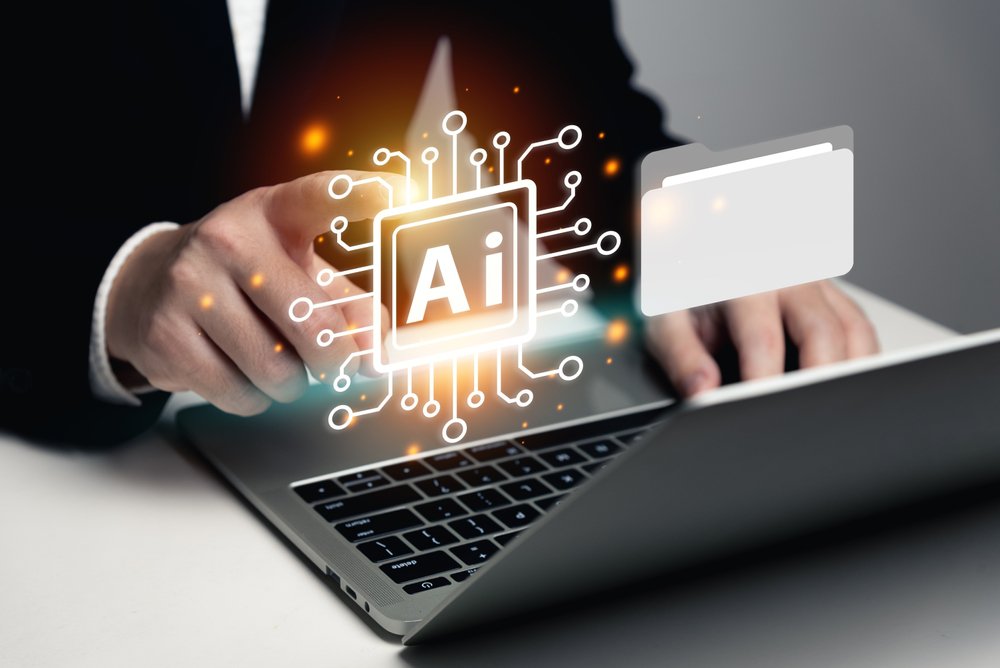How AI can be a tool for you

By Ingage.
Find out four ways that you can integrate AI into your workflow to be more efficient and effective.
As more businesses begin integrating artificial intelligence (AI) into their operations, there are more concerns and rumors floating around about the unknowns of the technology. The reality is that AI has been around for far longer than the last few years with the advent of ChatGPT. The first successful AI program actually ran over 60 years ago, when it played a game of checkers with a person. From there it has grown and evolved into chatbots and robot assistants like Siri, though it is far from the science fiction malevolence like Hal.
AI can be intimidating, but at the moment it is nothing more than a powerful tool. It has been integrated into workflows across fields, including search engines and social media to self-driving delivery vehicles. Learn from the experts here at Ingage to figure out how AI can be a tool for you.
Understanding AI and business
Contrary to popular belief, a business isn’t all about profitability. While turning a profit is crucial for the company to keep running, it’ll need growth in order to survive in the long-term. Those that insist on staying put will soon find themselves surrounded by competitors that offer better or cheaper products and services. By expanding their markets, businesses are better placed to stay profitable over time.
One of the great drivers of growth is improved efficiencies. Lowering operating costs outright won’t do much to encourage growth by itself. Instead, companies will need to find ways to sustain or enhance their operational efficiency even as they reduce costs. This is where artificial intelligence comes in.
While we often think of AI as sentient robots replacing humans doing menial work, the reality is a bit different. Artificial intelligence applications can, however, free human workers from repetitive and time-consuming tasks. This allows employees to turn the spotlight on more crucial aspects of their work — for instance, focusing on developing new programs to push the company forward.
Will AI ultimately replace human workers?
With the rapid rise of technology in the workplace, there are rumblings that AI and other modern marvels will soon replace humans completely. The answer at present remains a resounding “no!” The main reason for AI’s existence is to increase workflow efficiency. But in order to do so, you’ll need more than robots and algorithms taking the place of human workers.
Human presence remains a key component in workflows
As much as AI reduces turnaround time and human error, it needs humans to set the course. Like most technologies, AI will excel at its specific objectives and show a greater capacity to continually learn from situations. However, at this point, even the most complex machines need human direction. Developing the best and most efficient algorithms requires researchers, scientists, programmers and other skilled workers.
Until such time that a single computer can independently create and produce its own clones, humans will remain in charge. Granted, AI-powered machines look set to eventually take over jobs requiring a high degree of skill and accuracy. That said, it’s more likely that AI growth will open new industries and jobs that still require the human touch. Instead of factory workers and drivers, the world will start employing more people as engineers, software developers, designers and researchers.
In other words, there’s no reason to shun AI just because you’ve seen The Terminator, The Matrix or even Wall-E. At present, humans integrate AI technology to make work more efficient. However, even the best and most advanced technology can’t replicate what makes us human. AI-powered machines can take over jobs, but they won’t take over any part of the human experience. Instead of fearing AI, companies should rather adopt the mindset that technology is an instrument that won’t run by itself.

The four types of artificial intelligence
Before we get to the top reasons for companies to integrate AI into their workflows, note that artificial intelligence is not a static form of technology. During its 60-year existence, AI has come a long way. And even as it continues to evolve, it remains far away from achieving its optimal state.
Abraham Maslow’s famous Hierarchy of Needs theory states that humans are motivated by certain physiological and psychological needs. These range from basic necessities — such as food and shelter — to more complex needs, like friendship and personal growth. In other words, once a basic need is fulfilled, more complex ones will follow. For example, a jobless person might initially accept any sort of work. After a while, they would start wanting a better job with better pay. This goes on and on until they reach a point where money is no longer a motivator. Then they begin to search for other things to give meaning to their existence.
The development of artificial intelligence follows Maslow’s path. Its first iteration fulfills the basic requirements of recognizing input and providing related output. As technology progresses, AI’s objectives will likely increase in complexity as well.
Businesses relying on AI technology predominantly utilize types 1 and 2. In some cases, such as with self-driving cars and other autonomous machines, theory of mind applications are a desired outcome. However, we have some way to go before reaching that state of AI technology.
1 - Reactive machines: This is the stage that modern technology has managed to perfect. It entails a simple input-output operation, where AI helps recognize the input and produces an appropriate output. Reactive machines are the simplest form of AI as they do not need to learn.
2 - Limited memory: This is where AI technology is right now. Limited memory (LM) allows AI to store earlier data in order to develop better output. LM is the type of AI that learns from experience and machine learning is one of its branches. Nonetheless, the majority of LM applications are still used as reactive machines. Starting with training data, machines will collect feedback from external sources to improve such data. Along the way, it will generate new data based on feedback.
3 - Theory of mind: This type of artificial intelligence is in its early stages. Theory of mind means reaching a point where AI can interact with human emotions instead of simple input — but we’re not there yet. For example, today’s navigation systems will only provide recommendations for routes. They won’t change their output, even if a human expresses anger or frustration at the options.
4 - Self-awareness: When AI reaches the point that it becomes sentient, it achieves self-awareness. Futurists remain divided about self-aware machines, owing to the doomsday scenarios painted by science fiction writers. Many fear that once machines become sentient, humans will lose all control of the planet. However, the possibility of AI bringing self-awareness to machines remains in the realm of science fiction. At least for now.
Why you should integrate AI into your workflow
Integrating AI into workflows allows businesses to increase their efficiencies and concentrate on growth-enhancing pursuits. In addition, the technology can reduce the incidence of errors caused primarily by worker fatigue or boredom from repetitive tasks.

Another area where AI excels is in sales and marketing, where it can help unclog sales pipelines that seem to be perpetually stuck. When marketing staff and sales reps get bogged down in laborious, manual tasks, they tend to run out of time for what they really need to do. As a result, marketing teams get swamped executing campaigns instead of monitoring and analyzing results. Meanwhile, if they’re drowning in paperwork, sales teams lose valuable client facetime and miss out on closing opportunities.
AI has the potential to free sales, marketing, finance and other departments from the restrictions of labor-intensive and time-consuming tasks. This means more time to devote to the bigger picture — growing the company.
Now, let’s unpack the four top practical reasons to integrate AI into your workflow.
1 - Automate routine business operations
For many office roles, administrative tasks take up a large chunk of the workday. From the customer service rep at the frontline to the data analyst in the back office, regular reports are necessary to justify their existence. The act of composing the report itself is a chore that requires undivided attention. Add to that the fact that reports need to include information generated from the work period covered. Then imagine having to do these tasks manually, without any help from automation whatsoever.
The process of recording the data needed for your reports as well as writing the report itself uses up time that could be utilized to perform the employee’s actual job description. For sales representatives in particular, this means taking time from prospecting, making sales calls and closing deals. Meanwhile, customer service staff will hang up their headsets to write reports even as incoming calls light up the office like a Christmas tree.
Overall, when companies integrate AI into the workflow, things get done better and faster. Imagine having the right tools to automate your routine business operations. Using AI-powered software, sales teams generate reports automatically instead of doing it themselves. Important data — such as field visit details, customer purchase histories and order amounts — are now automatically pulled up from a central database and integrated into a rep’s active file. Analytics software will sift through the mounds of information to find correlations from different data points. Then, managers will go over these actionable insights with individual reps as part of improvement exercises.
The best part? Automation minimizes the time needed to record, gather and analyze the data that forms the basis of reports. This gives sales teams more time to do what they do best — approach clients to close deals.
At the same time, workers (not just sales reps) are fast evolving into developers. By continually interacting with AI, they provide the data needed to stimulate machine learning. The more employers use the software and provide feedback, the more the AI learns about the company workflow. As a result, the work process becomes even more optimized as time goes by. With less time spent on administrative tasks, more staff members can concentrate their efforts on growing the company.
2 - Provides virtual assistance
Customer service staff can also benefit from integrating AI with their workflows. An agent’s day typically involves replying to the same question from countless customers. Issuing the same standard reply for the hundredth time can take its toll on service staff swamped with calls. After all, it’s hard to keep up that cheerful tone day in and day out. Moreover, some callers might be less than pleased about having to interacting with someone who sounds bored or irritable.
Furthermore, companies may be wary of keeping customer service desks open 24/7 — both for budgetary and efficiency reasons. Employing three customer service shifts of eight hours each can take a big bite out of the operational budget. At the same time, what if the next PR crisis happens in the middle of the night when the phones are off the hook? There has to be a better way to achieve round-the-clock customer service.
Through the integration of AI, your customer service can improve. Even with business process outsourcing help, challenges such as overheads and staffing issues can mount up. Meanwhile, smaller companies with smaller operating budgets won’t even bother keeping phone lines open once the office closes. They simply cannot afford this level of service — even if their online stores remain active.
Virtual assistance is a popular branch of artificial intelligence that provides the customer service department with the relief it so often needs. By using AI-powered helplines, chatbots or virtual assistants to resolve common problems, businesses can fulfill the basic need to provide customer service without breaking their budget.
Moreover, by using software that can understand human language (whether voice or text), companies won’t have to worry about being deluged with calls. This technology is especially helpful during red-letter days, such as Black Friday or Cyber Monday sales. It also allows companies to continue providing basic customer service assistance even after office hours. Like most AI applications, chatbots and virtual assistants, the more feedback they receive, the better they get at the job.
3 - Foster innovation and creativity
Even with automated tools that increase their productivity, sales and marketing departments can still get swamped with work. According to Hubspot’s State of Marketing Report 2023, marketing teams are busier than ever. The average marketer usually juggles around five campaigns at a time, singlehandedly working on everything from creative development to campaign execution. In between, they’ll also need to devote time and energy to tedious manual work. Despite the modern tools available, many of these functions still involve repetitive tasks. This includes keyword research, social media post setup, blog formatting and data analysis.
Sadly, these tasks prevent them from focusing on the things that make the job enjoyable. For instance, creative and human-centric activities, such as marketing strategy and development, creative conceptualization and brand management.
In general, firms that integrate AI with marketing tasks are more efficient. Once the marketing manager signs off on a brand campaign, they can either have team members or an agency execute the plan. It usually takes a few days to develop the handles and marketing copy based on the creative brief. However, some campaigns don’t have a few days to spare. This is especially true for products and services in highly competitive marketplaces. Furthermore, many brands benefit from riding on current social media trends to get additional mileage. This means having enough agility to produce and publish content quickly.
Thankfully, generative AI can provide lightning-fast content to marketers in need of a quick fix. With tools such as ChatGPT, teams can utilize AI to produce high-quality copy within seconds of inputting relevant data. Even better, modern generative AI tools have the power to produce derivative images, audio and even code. Some tools, including Ingage, even include AI directly in their platform which allows you to quickly adjust presentation copy or even create a new outline.
Of course, generative AI does have some caveats. For one, the AI technology used in content creation tools is still relatively new. So, expect some hiccups as the underlying AI continues to learn from its mistakes. Nonetheless, its content generation abilities will improve rapidly as it continues to consume massive amounts of data. For the most part, the input quality will determine the output quality.
4 - Helps in making better decisions
For many companies, AI is all about analytics and insights. Modern organizations already possess the means and the discipline to collect every scrap of information generated by the entire work process. However, the challenge is having a person who can run through all that data to connect the dots and make insightful connections. And even if a company finds that person, it can take a lot of time to sift through all the data. In this fast-paced digital marketplace, time is something you simply don’t have. Acting a few days late can turn a marketing campaign from a rousing success into a dead loss.
At the same time, applying the human touch in respect of massive volumes of data can lead to critical errors, lapses in judgement and wrong assumptions. As a result, some manual reports might not stand up to academic challenges. Worse still, reviewers might point out glaring errors and inaccuracies that were completely avoidable.
Finally, yet another handicap of manual analytics is that it usually leaves a lot less time for teams to develop a good presentation to show the data to its intended audience. This can lead to presenters having difficulty in conveying the message, while the audience finds it equally difficult to comprehend the most salient points.
By integrating AI into analytics software, you can produce timely results. AI-powered analytics software can crunch data and generate insights much faster and more efficiently than humans can. At the same time, AI reduces — or even completely eliminates — the risk of human error. Instead, audiences can expect accurate, insightful analyses and projections that show the real situation. With AI committed to learning more along the way, the quality of insights should continue to improve as well.
By leveraging fast and automated analytics and insight generation, teams have more time to turn the results into an engaging presentation. Instead of rushing to come out with a report, they can fine-tune their presentation to present a clear and accurate picture. This leads to management having the information necessary to make timely and clear-cut decisions.

A few things to keep in mind before diving in
Artificial Intelligence is not the do-all and end-all technology that can solve the world’s problems. Like any other tool, the one holding it has the choice of turning plowshares into swords — or vice versa. More importantly, AI remains in a limited memory capacity. Putting in quality information can yield quality results. However, the opposite holds true should you input substandard data.
When using AI in your business, also be aware of applicable data privacy and transparency laws in your state. Not all information — especially private data — is fair game. Practicing ethics in handling, processing and storing data should always be the starting point in any work process. Your leadership often determines your team’s understanding of the need to handle data carefully.
Integrate AI in your presentations with Ingage
Integrating AI in your business workflow frees your workforce from the constraints of repetitive, manual tasks that can lead to inaccuracies, errors and delays in reporting. More importantly, AI can help you get the clearest snapshot of your business activities. It’s the best way to make timely, educated decisions — the type that lead to future business growth.
Ingage is a cloud-based interactive presentation software that features AI workflows. Utilize the AI feature, WriteIQ, to help you expertly outline and design copy for your presentation. Once your target recipient opens the Ingage presentation, built-in analytics features will track the user’s reactions to the presentation content. The software measures the impact of your content based on the time users spend browsing each section. Ingage also notes which aspects need further optimization, as it tracks areas where viewers showed little to no interest
In addition, Ingage facilitates cloud collaboration so that you and your team can work together on a single presentation, no matter your location. Once the presentation is completed, you can send your intended audience a link, which they can then view at their convenience. Integrate AI with your interactive presentations — visit us today and sign up for a free demonstration!
Original article source: Ingage
Learn more about Ingage in their Coffee Shop Directory or visit www.ingage.io.






















Comments
Leave a Reply
Have an account? Login to leave a comment!
Sign In